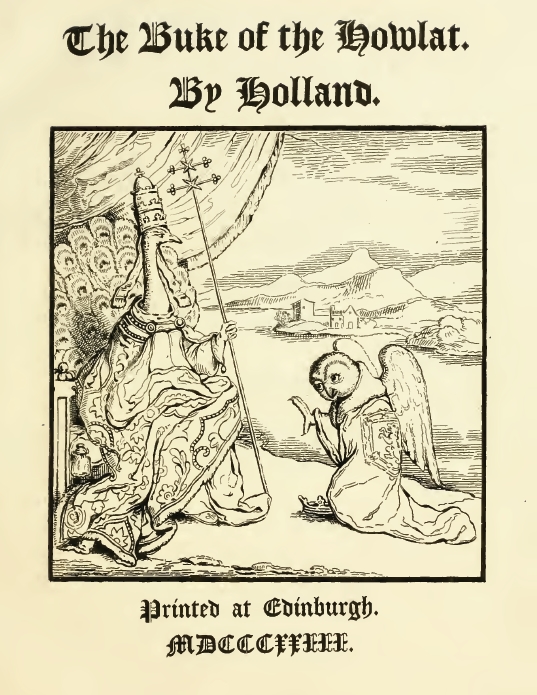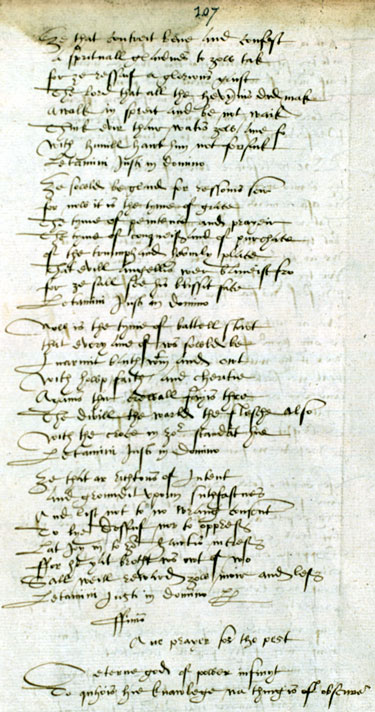|
Asloan Manuscript
The ''Asloan Manuscript'' is an anthology of Scots prose and poetry dating to the early sixteenth century. It was compiled by the Edinburgh notary ''John Asloan''. The manuscript's poetry consists of works by Henryson, Dunbar, Richard Holland and anonymous authors. The prose works consist of historical chronicles and religious and moral texts, often translations of famous works from elsewhere in Europe. It is held by the National Library of Scotland. Works represented in the manuscript Among the pieces preserved in the ''Asloan Manuscript'' are: *''Ane schort memoriale'' also known as the Auchinleck Chronicle, a history of the reign of James II preserved only in the ''Asloan manuscript''. * Henryson's "The tale of the twa mys" from the '' Morall Fabillis'' and ''The Tale of Orpheus and Erudices his Quene''. * Dunbar's ''The justis betuix the talzeour and the sowtar'' and ''Off the fenzeit fals frere of Tungland''. * Holland's ''Buke of the Howlat ''The Buke of the Ho ... [...More Info...] [...Related Items...] OR: [Wikipedia] [Google] [Baidu] |
James II Of Scotland (by Von Ehingen)
James II (16 October 1430 – 3 August 1460) was King of Scots from 1437 until his death in 1460. The eldest surviving son of James I of Scotland, he succeeded to the Scottish throne at the age of six, following the assassination of his father. The first Scottish monarch not to be crowned at Scone, James II's coronation took place at Holyrood Abbey in March 1437. After a reign characterised by struggles to maintain control of his kingdom, he was killed by an exploding cannon at Roxburgh Castle in 1460. Life James was born in Holyrood Abbey.Grants "Old and New Edinburgh" He was the son of King James I and Joan Beaufort. By his first birthday, his only brother, his older twin, Alexander, had died, thus leaving James as heir apparent with the title Duke of Rothesay. On 21 February 1437, James I was assassinated, and the six-year-old James immediately succeeded him as James II. He was crowned in Holyrood Abbey by Abbot Patrick on 23 March 1437. On 3 July 1449, the eighteen-y ... [...More Info...] [...Related Items...] OR: [Wikipedia] [Google] [Baidu] |
Buke Of The Howlat
''The Buke of the Howlat'', often referred to simply as ''The Howlat'', is a humorous 15th century Scots poem by Richard Holland. Description The poem is a comic allegory in which all the characters are birds with human attributes, with a howlet, or owl, the protagonist. The symbolism is debatable but two of its purposes are clear; it serves as a moral fable warning against vanity and excessive pride, and it is also a piece of propaganda praising the Douglas dynasty of Scots nobles. Other themes dealt with in the work include satire of the bureaucracy of the medieval church, and the mocking of Highland Scots and their language. ''The Howlat'' is a long, narrative piece full of exuberant comic detail. It is written in rhyming verse heavy with alliteration. The text is preserved in the Asloan and Bannatyne manuscripts. A printed transcript, based mainly on the Asloan text was published by the Bannatyne Club in 1823. Synopsis An owl, unhappy with his appearance, decides to ... [...More Info...] [...Related Items...] OR: [Wikipedia] [Google] [Baidu] |
16th-century Manuscripts
The 16th century begins with the Julian year 1501 ( MDI) and ends with either the Julian or the Gregorian year 1600 ( MDC) (depending on the reckoning used; the Gregorian calendar introduced a lapse of 10 days in October 1582). The 16th century is regarded by historians as the century which saw the rise of Western civilization and the Islamic gunpowder empires. The Renaissance in Italy and Europe saw the emergence of important artists, authors and scientists, and led to the foundation of important subjects which include accounting and political science. Copernicus proposed the heliocentric universe, which was met with strong resistance, and Tycho Brahe refuted the theory of celestial spheres through observational measurement of the 1572 appearance of a Milky Way supernova. These events directly challenged the long-held notion of an immutable universe supported by Ptolemy and Aristotle, and led to major revolutions in astronomy and science. Galileo Galilei became a champion of ... [...More Info...] [...Related Items...] OR: [Wikipedia] [Google] [Baidu] |
16th Century In Scotland
16 (sixteen) is the natural number following 15 and preceding 17. 16 is a composite number, and a square number, being 42 = 4 × 4. It is the smallest number with exactly five divisors, its proper divisors being , , and . In English speech, the numbers 16 and 60 are sometimes confused, as they sound very similar. Sixteen is the fourth power of two. For this reason, 16 was used in weighing light objects in several cultures. The British have 16 ounces in one pound; the Chinese used to have 16 ''liangs'' in one ''jin''. In old days, weighing was done with a beam balance to make equal splits. It would be easier to split a heap of grains into sixteen equal parts through successive divisions than to split into ten parts. Chinese Taoists did finger computation on the trigrams and hexagrams by counting the finger tips and joints of the fingers with the tip of the thumb. Each hand can count up to 16 in such manner. The Chinese abacus uses two upper beads to represent the 5s and 5 low ... [...More Info...] [...Related Items...] OR: [Wikipedia] [Google] [Baidu] |
Scottish Poetry
Poetry of Scotland includes all forms of verse written in Brythonic, Latin, Scottish Gaelic, Scots, French, English and Esperanto and any language in which poetry has been written within the boundaries of modern Scotland, or by Scottish people. Much of the earliest Welsh literature was composed in or near Scotland, but only written down in Wales much later. These include ''The Gododdin'', considered the earliest surviving verse from Scotland. Very few works of Gaelic poetry survive from this period and most of these in Irish manuscripts. ''The Dream of the Rood'', from which lines are found on the Ruthwell Cross, is the only surviving fragment of Northumbrian Old English from early Medieval Scotland. In Latin early works include a "Prayer for Protection" attributed to St Mugint, and ''Hiberno-Latin#Altus Prosator, Altus Prosator'' ("The High Creator") attributed to St Columba. There were probably filidh who acted as poets, musicians and historians. After the "de-gallicisation" ... [...More Info...] [...Related Items...] OR: [Wikipedia] [Google] [Baidu] |
British Anthologies
British may refer to: Peoples, culture, and language * British people, nationals or natives of the United Kingdom, British Overseas Territories, and Crown Dependencies. ** Britishness, the British identity and common culture * British English, the English language as spoken and written in the United Kingdom or, more broadly, throughout the British Isles * Celtic Britons, an ancient ethno-linguistic group * Brittonic languages, a branch of the Insular Celtic language family (formerly called British) ** Common Brittonic, an ancient language Other uses *''Brit(ish)'', a 2018 memoir by Afua Hirsch *People or things associated with: ** Great Britain, an island ** United Kingdom, a sovereign state ** Kingdom of Great Britain (1707–1800) ** United Kingdom of Great Britain and Ireland (1801–1922) See also * Terminology of the British Isles * Alternative names for the British * English (other) * Britannic (other) * British Isles * Brit (other) * Briton (d ... [...More Info...] [...Related Items...] OR: [Wikipedia] [Google] [Baidu] |
Alain Chartier
Alain Chartier (1430) was a French poet and political writer. Life Alain Chartier was born in Bayeux to a family marked by considerable ability. His eldest brother Guillaume became bishop of Paris; and Thomas became notary to the king. Jean Chartier, a monk of St Denis, whose history of Charles VII is printed in vol. III. of ''Les Grands Chroniques de Saint-Denis'' (1477), is also said to have been a brother of the poet. Alain studied, as his elder brother had done, at the University of Paris. He then went to work for the Duke Louis and Yolande of Anjou, whose daughter Marie was engaged to the youngest son of Charles VI. He followed the fortunes of the dauphin, afterwards Charles VII, acting in the triple capacity of clerk, notary, and financial secretary. He later would become a member of several important ambassadorial trips, serving as orator and secretary for Charles VII, traveling to Vienna and Buda to see Sigismund; to Venice to appear before the Senate, to Rome to del ... [...More Info...] [...Related Items...] OR: [Wikipedia] [Google] [Baidu] |
Jacobus De Cessolis
Jacobus de Cessolis ( it, Jacopo da Cessole; c. 1250 – c. 1322) was an Italian author of the most famous morality book on chess in the Middle Ages. In the second half of the 13th century, Jacobus de Cessolis, a Dominican friar in Cessole (Asti district, Piemonte, Northern Italy) used chess as the basis for a series of sermons on morality. They later became ''Liber de moribus hominum et officiis nobilium super ludo scacchorum'' ('Book of the customs of men and the duties of nobles or the Book of Chess'). The popular work was translated into many other languages and was first printed in Utrecht in 1473. Chess historian Harold Murray asserts that the popularity of the work rivaled "that of the Bible itself." The work was the basis for William Caxton's '' The Game and Playe of the Chesse'' (1474), one of the first books printed in English.Jacobus, d. Cessolis., Axon, W. E. A. (William Edward Armytage)., Caxton, W. (1883)Caxton's Game and playe of the chesse, 1474 London: E. Stoc ... [...More Info...] [...Related Items...] OR: [Wikipedia] [Google] [Baidu] |
The Fenyeit Freir Of Tungland
is a comic, satirical poem in Scots by William Dunbar (born 1459 or 1460) composed in the early sixteenth century. The title may be rendered in modern English as ''A Ballad of The False Friar of Tongland, How He Fell in the Mire Flying to Turkey''. The poem mocks an apparent attempt by John Damian, the abbott of Tongland, to fly from a wall of Stirling Castle using a pair of artificial wings. While pillorying this event, Dunbar makes a broader attack on Damian's character, depicting him as a habitual charlatan.W. Mackay Mackenzie, ''The Poems of William Dunbar'', The Mercat Press, 1990.The full text with notes at TEAMS The text of the poem is preserved in the '' |
Scots Language
Scots ( endonym: ''Scots''; gd, Albais, ) is an Anglic language variety in the West Germanic language family, spoken in Scotland and parts of Ulster in the north of Ireland (where the local dialect is known as Ulster Scots). Most commonly spoken in the Scottish Lowlands, Northern Isles and northern Ulster, it is sometimes called Lowland Scots or Broad Scots to distinguish it from Scottish Gaelic, the Goidelic Celtic language that was historically restricted to most of the Scottish Highlands, the Hebrides and Galloway after the 16th century. Modern Scots is a sister language of Modern English, as the two diverged independently from the same source: Early Middle English (1150–1300). Scots is recognised as an indigenous language of Scotland, a regional or minority language of Europe, as well as a vulnerable language by UNESCO. In the 2011 United Kingdom census, 2011 Scottish Census, over 1.5 million people in Scotland reported being able to speak Scots. As there are ... [...More Info...] [...Related Items...] OR: [Wikipedia] [Google] [Baidu] |
.jpg)







